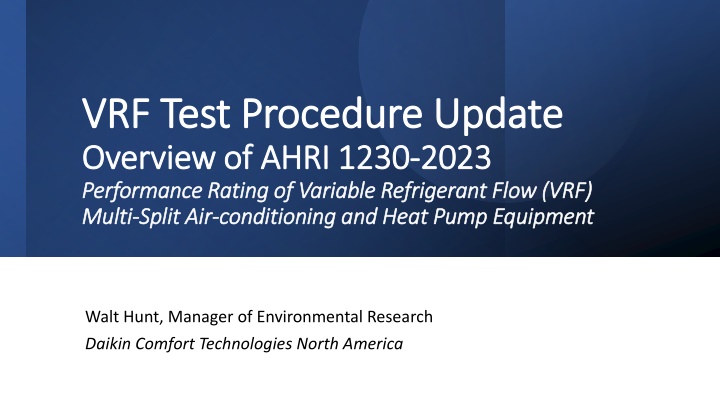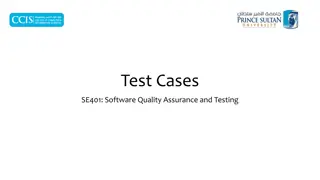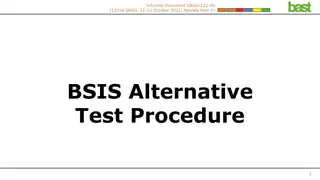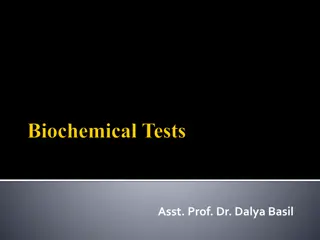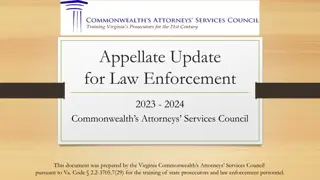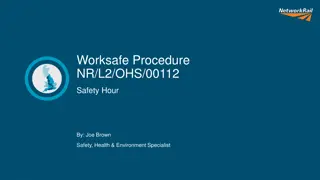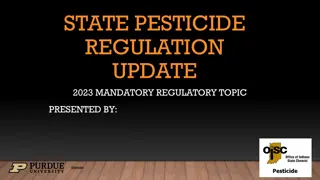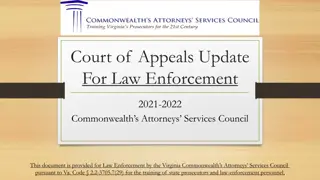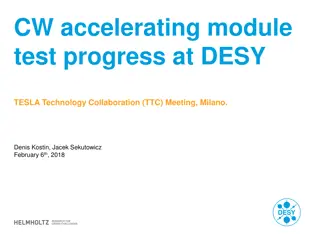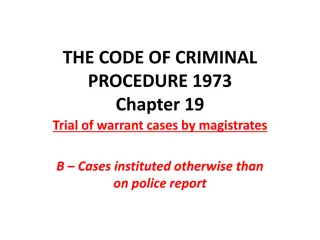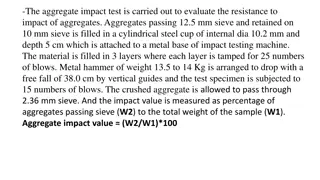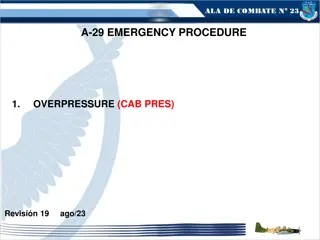AHRI 1230-2023 Update: VRF Test Procedure Changes Overview
The AHRI 1230-2023 update brings significant changes to the performance rating of Variable Refrigerant Flow (VRF) systems. This update covers key modifications like Sensible Heat Ratio limits, Controls Verification Procedure, and more. The new standard applies to various VRF systems and aims to enhance efficiency and accuracy in testing procedures.
Download Presentation

Please find below an Image/Link to download the presentation.
The content on the website is provided AS IS for your information and personal use only. It may not be sold, licensed, or shared on other websites without obtaining consent from the author.If you encounter any issues during the download, it is possible that the publisher has removed the file from their server.
You are allowed to download the files provided on this website for personal or commercial use, subject to the condition that they are used lawfully. All files are the property of their respective owners.
The content on the website is provided AS IS for your information and personal use only. It may not be sold, licensed, or shared on other websites without obtaining consent from the author.
E N D
Presentation Transcript
VRF Test Procedure Update VRF Test Procedure Update Overview of AHRI 1230 Overview of AHRI 1230- -2023 Performance Rating of Variable Refrigerant Flow (VRF) Performance Rating of Variable Refrigerant Flow (VRF) Multi Multi- -Split Air Split Air- -conditioning and Heat Pump Equipment conditioning and Heat Pump Equipment 2023 Walt Hunt, Manager of Environmental Research Daikin Comfort Technologies North America
Agenda Agenda Scope of AHRI 1230-2023 Key changes from prior test procedure Sensible Heat Ratio (SHR) limits Controls Verification Procedure (CVP) Example calculations
Scope of AHRI 1230 Scope of AHRI 1230- -2023 2023 AHRI 1230-2023 applies to: VRF Multi-Split Air-Conditioners and VRF Multi-Split Heat Pumps. Including VRF Air-source systems with Cooling Capacity 65,000 Btu/h. Including VRF Water-source systems of any Cooling Capacity. Including VRF with and without heat recovery. Including Ducted, Non-Ducted, and Mixed Indoor Units VRF = Variable Refrigerant Flow
Variable Refrigerant Flow (VRF) System Variable Refrigerant Flow (VRF) System 1230-2023 Definition of Variable Refrigerant Flow System: An engineered direct expansion (DX) air-conditioning of Heat Pump multi-split system that incorporates the characteristics and components: A single refrigerant circuit that has common piping network to multiple indoor units; Single Module or Combined Module Outdoor Units; Two or more Indoor Units; Three or more steps of capacity; and A zone temperature control device such as a thermostat.
Standard Rating Tests for VRF Air Standard Rating Tests for VRF Air- -Source Systems Cooling Operation Cooling Operation Source Systems IEER Test Points for Air-Cooled Equipment Single-Point EER Multi-Point IEER Outdoor Dry-bulb IEER Weighting 100% Full-load (EER) 95.0 F 2.0% 75% Part-load 81.5 F 61.7% 50% Part-load 68.0 F 23.8% 25% Part-load 65.0 F 12.5% Indoor Condition: 80 F dry-bulb; 67 F wet-bulb
Whats the Significance of What s the Significance of AHRI 1230 AHRI 1230- -2023 2023? ? AHRI 1230-2023 became effective for AHRI VRF Certification Program on January 1st, 2024. Compared to AHRI 1230-2014 with Addendum 1 (previous test procedure for AHRI VRF program), there are major revisions for determining IEER and EER for a VRF system. AHRI 1230-2023 is more stringent than the previous VRF test procedure. AHRI 1230-2023 IEER, EER AHRI 1230-2014(with Addendum 1) IEER, EER
Whats the Significance of What s the Significance of AHRI 1230 Major Test Procedure Revisions from Prior Standard Major Test Procedure Revisions from Prior Standard AHRI 1230- -2023 2023? ? AHRI 1230-2014 (with Addendum 1) AHRI 1230-2023 SHR Limit at 100% Full-load test SHR Limit at 75% Part-load test Sensible Heat Ratio (SHR) Limits None Ensures compressor speed(s), outdoor fan speed(s), and outdoor valve position(s) during testing align with native controls. Controls Verification Procedure (CVP) None
Transition to AHRI 1230 Transition to AHRI 1230- -2023 Example Impact to IEER Metric Example Impact to IEER Metric 2023 In 2019 as part of DOE negotiated rulemaking process, multiple VRF manufacturers through AHRI evaluated impact of new test procedures through testing or simulation. These sample VRF systems provide an example of the rated efficiency impact of the new test procedure (AHRI 1230-2023). IEER Impact of Revised Test Procedures 2019 AHRI Study IEER IEER Percent Reduction AHRI 1230-2014 (with Addendum 1) AHRI 1230-2023 Average of Air-Cooled VRF Equipment Examined Range of Air-Cooled VRF Equipment Examined 13.1% 21.99 18.87 15.61 25.68 15.14 22.62 2.5 25.6% For a specific VRF system, IEER and EER impact of new test procedure will vary.
Transition to AHRI 1230 Transition to AHRI 1230- -2023 Example Impact to EER Metric Example Impact to EER Metric 2023 In 2019 as part of DOE negotiated rulemaking process, multiple VRF manufacturers through AHRI evaluated impact of new test procedures through testing or simulation. These sample VRF systems provide an example of the rated efficiency impact of the new test procedure (AHRI 1230-2023). EER Impact of Revised Test Procedures 2019 AHRI Study EER EER Percent Reduction AHRI 1230-2014 (with Addendum 1) AHRI 1230-2023 Average of Air-Cooled VRF Equipment Examined Range of Air-Cooled VRF Equipment Examined 15.8% 11.6 9.8 10.6 13.3 8.8 12.1 7.9 20.1% For a specific VRF system, IEER and EER impact of new test procedure will vary.
ASHRAE 90.1 ASHRAE 90.1- -2022 Minimum Efficiency Requirements for VRF Heat Pumps Minimum Efficiency Requirements for VRF Heat Pumps 2022 Size Category Subcategory Minimum Efficiency 65,000 Btu/h and <135,000 Btu/h VRF multi-split system 11.0 EER Before 1/1/2024 10.3 EER On or after 1/1/2024 VRF multi-split system with heat recovery 10.8 EER Before 1/1/2024 10.1 EER On or after 1/1/2024
Sensible Heat Ratio Limits in AHRI 1230 Sensible Heat Ratio Limits in AHRI 1230- -2023 2023 Sensible Heat Ratio (SHR) Limit for 100% and 75% test points (IEER) Sensible Heat Ratio (SHR) Limit 0.82 100% Cooling Load Test at 95.0 F 0.85 75% Cooling Load Test at 81.5 F
Test Adjustments and EER Adjustments (as needed) if Sensible Heat Test Adjustments and EER Adjustments (as needed) if Sensible Heat Ratio Limits not Achieved in AHRI 1230 Ratio Limits not Achieved in AHRI 1230- -2023 2023 Step 1: Test Adjustments if SHR Limit not Achieved Allowable Critical Parameter Adjustment for Meeting SHR Limits (Section 6.3.3.2) Incrementally increase compressor speed up to +3% capacity tolerance. Step 2: Test EER Penalty if SHR Limit not Achieved through Step 1
Test Adjustments and EER Adjustments (as needed) if Sensible Heat Test Adjustments and EER Adjustments (as needed) if Sensible Heat Ratio Limits not Achieved in AHRI 1230 Ratio Limits not Achieved in AHRI 1230- -2023 2023 Example 5 from Appendix G from AHRI 1230-2023 Example of SHR test and EER penalty adjustments at 100% Load, 95 F test point. SHR Limit of 0.82 at test point. Step SHR EER Initial Test Results 0.86 11.14 Step 1: Adjusted Test Result 0.84 11.08 Step 2: EER Penalty 0.82 9.84
AHRI 1230 AHRI 1230- -2023 Definition of 2023 Definition of Critical Parameters Critical Parameters AHRI 1230-2023 Critical Parameters definition: Key variables affecting the measured result. Any operating state or position for a component, either set manually or automatically by System Controls that can impact system performance. The settings of modulating components of a VRF System are compressor speed(s), outdoor fan speed(s), and outdoor variable valve position(s). VRF System Critical Parameters: Compressor Speed(s) Outdoor Fan Speed(s) Outdoor Variable Valve Position(s)
AHRI 1230 AHRI 1230- -2023 Setting Setting Critical Parameters for IEER Test Points Critical Parameters for IEER Test Points 2023 Section 5.1.2.1 of AHRI 1230-2023 At each load point, Critical Parameters shall be set to the values in the Supplemental Testing Instructions. Once set, Control Settings shall remain unchanged for the remainder of test (except for allowable adjustment of Critical Parameters
Overview of AHRI 1230 Overview of AHRI 1230- -2023 Controls Verification Procedure 2023 Controls Verification Procedure Controls Verification Procedure (CVP): Ensures compressor speed(s), outdoor fan speed(s), and outdoor valve position(s) during steady-state testing align with native controls. During Controls Verification Procedure (CVP): Native controls of VRF system control the critical parameters. Dry-bulb indoor temperature starts elevated and then is steadily ramped down. In response, VRF system (under native controls) starts near rated capacity, and then ramps down to part-load capacities. As VRF system ramps down, a budget/points system evaluates the agreement of critical parameters under native controls and those used for steady-state testing.
Schematic of Controls Verification Procedure (CVP) Schematic of Controls Verification Procedure (CVP) Indoor Dry Bulb Temperature ( F) Compressor Speed (Hz) Thermally Active Indoor Units
Indoor Dry Bulb Temperature Indoor Dry Bulb Temperature Controls Verification Procedure (CVP) Indoor Dry Bulb Temperature ( F) T-off CVP Start CVP End
Compressor Speed Compressor Speed Controls Verification Procedure (CVP) CVP Start CVP End T-off Compressor Speed (Hz)
Thermally Active Units Thermally Active Units Controls Verification Procedure (CVP) CVP Start T-off CVP End Reported Thermally Active Indoor Unit, N Thermally Active Indoor Units
Controls Verification Procedure Controls Verification Procedure R2 Period and Calculating Critical Parameter Variation R2 Period and Calculating Critical Parameter Variation R2 Period Definition: From the time that the measured indoor room dry bulb temperature first crosses from greater than 82F to less than 82F The R2 period ends at the time when any Indoor Unit that is designated Thermally Active at the start of the CVP goes Thermally Inactive (t-off). Calculating Critical Parameter Variation during R2 Period: At each data collection interval during the R2 period, determine percent difference between each measured Critical Parameter value and the Critical Parameter value used for IEER testing. During R2 period, calculate the RSS Points Total using specified equations. Critical Parameters (used for IEER testing) are valid if average RSS Points Total is less than or equal to 70 points over specified time period.
Calculating Critical Parameter Variation Calculating Critical Parameter Variation Controls Verification Procedure Controls Verification Procedure Step 1: Critical Parameter Percent Difference Step 2: Nominal Points Adjustment Nominal Point Value Critical Parameter Compressor Speed(s) 13 Outdoor Fan Speed(s) 7 Outdoor Variable Value Position(s) 1 Step 3: RSS Points Calculation
AHRI 1230 AHRI 1230- -2023 Examples of IEER Calculations 2023 Examples of IEER Calculations Appendix G Appendix G Example 1 Example 1
AHRI 1230 AHRI 1230- -2023 Examples of CVP Calculations 2023 Examples of CVP Calculations Appendix H Appendix H Example 1 Example 1
AHRI 1230 AHRI 1230- -2023 Examples of CVP Calculations 2023 Examples of CVP Calculations Appendix H Appendix H Example 1 continued Example 1 continued
Whats the Significance of What s the Significance of AHRI 1230 AHRI 1230- -2023 2023? ? AHRI 1230-2023 became effective for AHRI VRF Certification Program on January 1st, 2024. Compared to AHRI 1230-2014 with Addendum 1 (previous test procedure for AHRI VRF program), there are major revisions for determining IEER and EER for a VRF system. AHRI 1230-2023 is more stringent than the previous VRF test procedure. AHRI 1230-2023 IEER, EER AHRI 1230-2014(with Addendum 1) IEER, EER
Whats the Significance of What s the Significance of AHRI 1230 Major Test Procedure Revisions from Prior Standard Major Test Procedure Revisions from Prior Standard AHRI 1230- -2023 2023? ? AHRI 1230-2014 (with Addendum 1) AHRI 1230-2023 SHR Limit at 100% Full-load test SHR Limit at 75% Part-load test Sensible Heat Ratio (SHR) Limits None Ensures compressor speed(s), outdoor fan speed(s), and outdoor valve position(s) during testing align with native controls. Controls Verification Procedure (CVP) None
